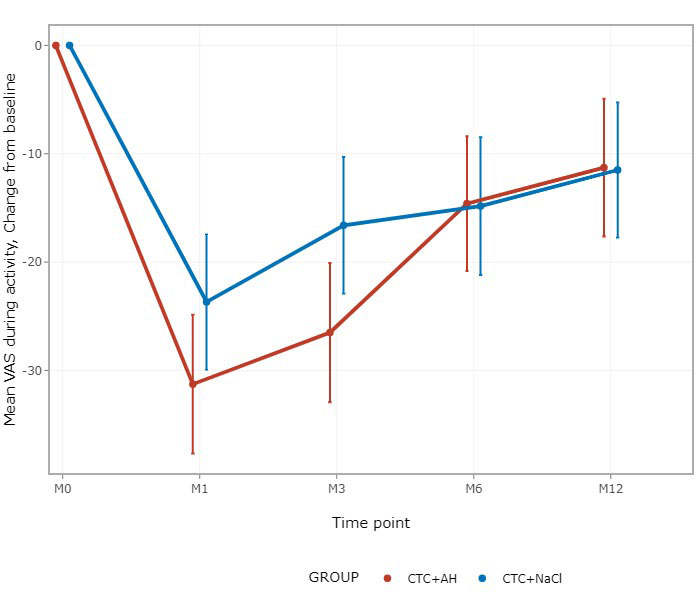Session Information
Session Type: Poster Session D
Session Time: 1:00PM-3:00PM
Background/Purpose: Trapeziometacarpal osteoarthritis is highly prevalent (affects 10 to 25% of people). Treatment modalities consist of non-pharmacological and pharmacological measures, including either corticosteroid or hyaluronic acid (HA) injections. Both types of injections appear to be efficacious but with different response patterns, the corticosteroids having a rapid analgesic whereas the HA giving a delayed but sustained action over time. Although widely performed in clinical practice, there are still controversies on the interest of the association of these 2 treatments in a single injection on pain and function in the short and long term. Our hypothesis was that the association of steroid and HA would be superior to steroid alone on TMC osteoarthritis pain.
The goal of this study was to compare the effect on pain at 3 months of corticosteroids injections performed with or without HA in patients with TMC osteoarthritis.
Methods: This was a multicenter prospective, placebo-controlled, double-blinded, randomized study. We included patients with pain at the thumb base (confirmer by X-ray) resistant to medical therapy with a mean pain VAS ≥ 4 at activity for over 3 months. Patients were treated with intra-articular ultrasound-guided injection with steroids followed by placebo or steroids followed by HA . The evaluators and patients were blinded to the treatment group. The primary outcome was the VAS pain during activity at 3 months. Secondary outcomes were evolution of VAS pain at rest and during activities, evolution of functional scale and grip strength at 1 month, 6 et 12 months. Change from baseline in VAS pain, Cochin score and grip strength were analysed using a linear mixed model.
Results: We included 150 patients, mean age 62 (+/- 9) years, 123 females (83 %). The median BMI was 26.9 (+/- 5.6). The injection could be performed in all patients, partially in 16% of them. We notified infrequent side effects (3 in AH group, 7 in placebo) with minor impact. Our primary outcome was met as pain VAS during activity, decreased significantly more in the HA+steroid group at 3 months. Change from baseline in VAS pain during activity was significantly greater in the HA group (-26.5) versus in the placebo group (-16.6), p=0.023.
The difference was already significant at M1 but without difference after. Change from baseline in VAS pain during activity was -31.2, -14.6, -11.3 in the HA+steroïd group and -23.7, -14.8, -11.5 at M1, M6 and M12. Pain at rest also showed a trend but not significant difference. We did not find significant differences in function at any time point. Concerning the strength, there was no difference. The need for a new injection was higher in the steroid group: 15 versus 9 ; without significative difference. Only 5 patients underwent surgery after one year follow-up (3 and 2 patients respectively).
Conclusion: Our study shows that the injection of HA and steroids leads to a significant improvement in pain during activity compared to the injection of steroid alone at 3 months. Surprisingly the effect of HA does not last after 3 months as we would initially have expected. In view of these results, intra-articular injection of HA and steroids could be recommended in the treatment of TMC osteoarthritis.
To cite this abstract in AMA style:
Cormier G, Denis A, LESKE C, Varin S, Dimet J, Planche L, Le Goff B. Corticosteroids with or Without Hyaluronic Acid Injections in the Treatment of Trapeziometacarpal (TMC) Osteoarthritis : The Randomised Multicentre RHIZ’ART Trial Study Protocol [abstract]. Arthritis Rheumatol. 2022; 74 (suppl 9). https://acrabstracts.org/abstract/corticosteroids-with-or-without-hyaluronic-acid-injections-in-the-treatment-of-trapeziometacarpal-tmc-osteoarthritis-the-randomised-multicentre-rhizart-trial-study-protocol/. Accessed .« Back to ACR Convergence 2022
ACR Meeting Abstracts - https://acrabstracts.org/abstract/corticosteroids-with-or-without-hyaluronic-acid-injections-in-the-treatment-of-trapeziometacarpal-tmc-osteoarthritis-the-randomised-multicentre-rhizart-trial-study-protocol/

